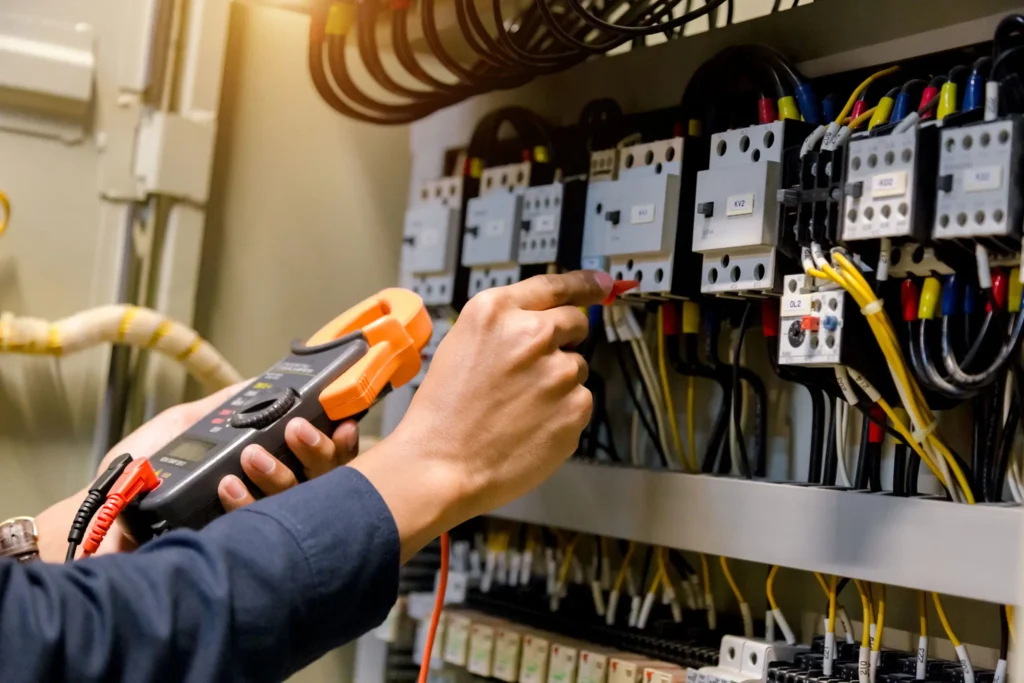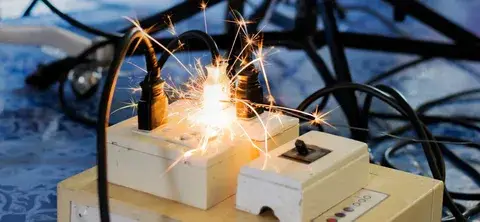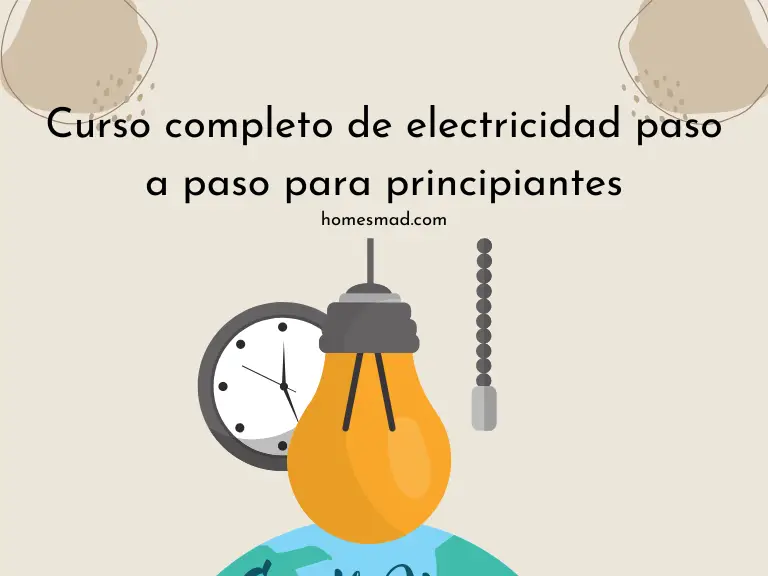Introduction to Complete step-by-step electricity course for beginners
Electricity is an essential part of our daily lives, powering everything from the lights we switch on in the morning to the devices we use throughout the day. But for many, it remains a mysterious force—something that seems too complex to understand or deal with. However, learning electricity step by step can empower anyone to not only fix common electrical problems around the house but also explore a potential career in this indispensable field. In this guide, we’ll break down the basics of electricity, providing a comprehensive course that will take you from a complete beginner to confidently handling your own electrical projects. Whether you’re interested in basic residential electrical work or want to become familiar with the tools and techniques used by professionals, this article is for you.
Introduction to Basic Electricity
What is Electricity?
At its core, electricity is a form of energy that powers most of the devices and appliances we use daily. It travels through conductors—materials that allow electricity to flow—like copper wires. But how does electricity work, exactly? Well, the simplest way to understand it is by looking at three key concepts: voltage, current, and resistance.
- Voltage is the force that pushes electricity through a conductor.
- Current is the flow of electricity, measured in amperes.
- Resistance is the opposition to the flow of electricity, similar to how friction slows down moving objects.
By understanding how these elements interact, you’ll have a solid foundation for everything that follows in this course.
AC vs DC Electricity
When talking about electricity, it’s important to know that there are two primary types: alternating current (AC) and direct current (DC). While AC flows back and forth, DC flows in one direction, providing power to most of our household devices. AC, on the other hand, is typically used in the electrical grid to transport electricity over long distances. Both types are essential in modern electrical systems, but for home use, you’ll mostly deal with AC.
Basic Electrical Safety
Before diving into any electrical project, safety must come first. Whether you’re working on a simple repair or installing new wiring, always follow proper safety protocols. This includes turning off the power at the circuit breaker, using insulated tools, and wearing protective gear like gloves. Remember, electricity can be dangerous, and taking the proper precautions can prevent accidents and injuries.
To learn more about basic electrical safety, check out the resources offered by the Electrical Safety Foundation International here.
In the next section, we will start exploring the fundamentals of electrical circuits, the building blocks for everything else in this course!

Fundamental Electrical Concepts
Understanding Circuits
A circuit is the pathway through which electricity flows. Without circuits, electrical power would have no direction or control. At its most basic, a circuit needs three things: a power source (such as a battery), a conductive path (like copper wiring), and a load (such as a light bulb). But it’s not just about connecting wires together. How those components are connected determines how electricity behaves in the system.
- Series Circuit: In a series circuit, all components are connected in a single path. This means that if one component fails, the entire circuit stops working. For example, if a light bulb goes out in a series circuit, all the lights will turn off. This setup is rarely used in homes for lighting but can be useful in some applications like string lights.
- Parallel Circuit: In a parallel circuit, each component is connected separately to the power source. This allows for greater reliability—if one component fails, the others continue to function. This is the type of circuit you’ll encounter most often in your home, such as in electrical outlets, light switches, and other household electrical systems. Parallel circuits are essential because they ensure that one faulty device doesn’t bring down the whole system.
Understanding the difference between series and parallel circuits is critical for anyone learning how to install or repair household wiring. By the end of this course, you’ll be able to identify which type of circuit is best for each situation.
Materials and Tools Needed for Electricity Projects
One of the first steps to learning electrical work is understanding the tools and materials you’ll need. When dealing with electricity, conductors and insulators play a huge role in ensuring your circuits work safely.
- Conductors: These materials, like copper and aluminum, allow electricity to flow easily. You’ll often see copper wires used in most household wiring.
- Insulators: Insulating materials, such as rubber or plastic, prevent electricity from escaping and ensure that wires don’t short out. Insulated tools are a must when working with live wires because they protect you from electrical shock.
As a beginner, you don’t need a huge toolbox, but a few basic tools are essential for any electrical job:
- Multimeter: To measure voltage, current, and resistance.
- Wire Strippers: To safely remove the insulation from wires.
- Screwdrivers: To install or remove electrical devices like switches and outlets.
- Electrical Tape: Used to secure wires and ensure connections are safe.
Once you have these tools, you’ll be ready to start working on simple electrical tasks, from fixing a broken light switch to installing new outlets.
Electrical Symbols and Diagrams
If you’re diving into electrical work, sooner or later you’ll encounter electrical schematics—diagrams that show the layout of a circuit. These diagrams use symbols to represent different electrical components, such as resistors, switches, and wires. Learning how to read these symbols is an important step in understanding how circuits function.
Some of the most common symbols include:
- Resistor: A zig-zag line.
- Switch: A break in the line, indicating that the current can be turned on or off.
- Battery: A pair of long and short lines stacked, representing the positive and negative terminals.
Electrical diagrams may look confusing at first, but they’re an essential part of working with electrical systems. The more familiar you become with these symbols, the easier it will be to understand and troubleshoot circuits.
For an in-depth explanation of symbols and diagrams, take a look at some of the practical resources available, such as “Everything You Need to Know About Electrical Symbols”.
Understanding these fundamental concepts lays the foundation for everything else in this course. In the next part, we’ll start diving into practical wiring and installation techniques.
Wiring and Installing Electrical Components
Wiring Basics
It is a fundamental skill for anyone learning electricity. It’s all about connecting the right components in the right way, ensuring the electrical current can travel safely and efficiently to its destination. Whether you’re wiring an outlet, installing a ceiling fan, or adding a new light fixture, understanding the basics of wiring will help you complete these tasks confidently.
- Choosing the Right Wire
Not all wires are the same! Electrical wires come in various gauges (thicknesses) and materials, and the wire you choose depends on the job. For instance, 14-gauge copper wire is commonly used for light fixtures, while 12-gauge wire is better suited for larger appliances like refrigerators or air conditioners. The thicker the wire, the more current it can carry. - Stripping and Connecting Wires
When preparing wires, you need to strip off the insulation (the protective plastic or rubber coating) without damaging the wire inside. Wire strippers make this process easy, allowing you to remove just enough insulation to make a good connection. When you connect wires, be sure to twist them together tightly using wire connectors to prevent any loose or exposed wires, which could lead to short circuits. - Polarity Matters
When connecting wires to outlets or switches, it’s important to pay attention to polarity. This simply means connecting the right wire to the correct terminal. For instance, in a standard outlet, the black (hot) wire should go to the brass screw, while the white (neutral) wire goes to the silver screw. Miswiring can lead to electrical hazards like shorts or shocks.
Installing Electrical Components
Now that you’ve got a grasp on basic wiring, it’s time to learn how to install key electrical components, such as outlets, switches, and light fixtures. Let’s break it down step by step:
- Installing a Light Switch
- First, turn off the power at the breaker box.
- Remove the old switch (if replacing) by unscrewing the switch plate and disconnecting the wires.
- Connect the new switch by attaching the black (hot) wire to the terminal marked “common,” and the white (neutral) wire to the silver terminal. Tighten the screws securely.
- Once everything is connected, install the switch into the electrical box and screw the plate back on.
- Installing a New Outlet
- Start by cutting off the power to the circuit.
- Remove the existing outlet (if applicable) and loosen the screws that hold the wires in place.
- Attach the new outlet, ensuring that the hot wire goes to the brass terminal, the neutral wire to the silver terminal, and the ground wire (if present) to the green terminal.
- Once securely attached, install the outlet back into the box and screw the cover plate on.
- Installing a Light Fixture
- Turn off the power and remove the old light fixture (if replacing).
- Connect the new fixture’s wires to the appropriate wires in the ceiling box. Generally, the black (hot) wire connects to the fixture’s black (hot) wire, and the white (neutral) wire to the fixture’s white (neutral) wire.
- If the fixture has a ground wire, connect it to the metal box or the green screw.
- Secure the fixture to the ceiling, reattach the power, and test the light.

Understanding Electrical Overloads and Protection
As you work with electricity, it’s essential to understand overloads and how to protect your circuits from damage. Electrical overloads happen when too much current flows through a wire, which can cause overheating and even fires. Circuit protection devices like fuses and circuit breakers are designed to prevent this by interrupting the flow of electricity when an overload is detected.
- Fuses: These are designed to blow when the current becomes too high, breaking the circuit and preventing further damage.
- Circuit Breakers: A more modern solution, circuit breakers automatically switch off when the current becomes excessive, and they can be reset once the issue is resolved.
When installing any electrical component, always ensure that the circuit is properly protected by the appropriate breaker or fuse size for the job.
For more on how to wire and install electrical components, be sure to check out practical guides such as those offered by the National Electrical Code here. These resources offer detailed instructions on installation and safety.
In the next section, we’ll focus on electrical safety—ensuring that your work doesn’t just function correctly, but that it’s also safe!
Safety Measures in Electrical Work
Electrical Safety Essentials
When it comes to electrical work, safety is paramount. Whether you’re replacing a light switch or wiring an outlet, working with electricity presents inherent risks. However, by following proper safety procedures, you can minimize these risks and ensure that your electrical projects are completed safely.
- Turn Off the Power
Before starting any electrical work, the first and most important step is to cut off the power. This is done at the circuit breaker panel, which allows you to isolate the electrical circuit you’re working on. Always double-check that the power is off using a non-contact voltage tester to ensure that you’re not working on live wires. - Use Insulated Tools
Electrical work requires tools that prevent accidental contact with live wires. Always use tools that have insulated handles, especially when working with wires that are not visibly disconnected from the power source. Insulated tools protect you from electric shock, giving you an extra layer of safety when working in tight spaces or near live circuits. - Wear Safety Gear
In addition to insulated tools, wearing appropriate safety gear can make a significant difference. This includes rubber gloves, which provide an added level of insulation, and safety glasses to protect your eyes from sparks or debris. - Properly Grounding Electrical Work
Grounding is an essential part of any electrical system, as it provides a safe path for electricity to flow in the event of a fault or overload. Make sure that all your electrical components, such as outlets and switches, are properly grounded. The ground wire (typically green or bare copper) should always be attached to the ground screw of the outlet or fixture.
By following these simple safety measures, you can significantly reduce the risk of electrical accidents. However, safety is not just about the tools and equipment—it’s about being aware and vigilant during every step of the process.
Common Electrical Hazards
While electrical work can be rewarding, it also comes with potential hazards. Familiarizing yourself with the risks involved is a crucial step in staying safe.
- Electric Shock
One of the most common hazards is the risk of electrical shock. This can happen if you accidentally touch live wires or come into contact with energized electrical components. To prevent this, always ensure that the power is off, use insulated tools, and never work with electrical systems while standing on a wet surface or in contact with water. - Overloaded Circuits
Overloading a circuit can result in overheating, which can lead to a fire. This happens when more current flows through a wire than it can safely carry. Overloaded circuits are a common cause of electrical fires, so make sure you’re aware of the limits of your electrical system and use the correct wire gauge and breakers for the job. - Electrical Fires
Faulty wiring, damaged cords, or improper use of electrical equipment can lead to fires. Always check that your wiring is intact and properly insulated, and be cautious when using high-wattage appliances in circuits that may not be designed to handle them.
By staying vigilant and understanding these potential hazards, you can protect both yourself and your home from electrical accidents.

How to Safely Handle Tools and Equipment
Handling electrical tools with care is another essential part of ensuring safety during electrical work. Proper use and maintenance of tools will not only protect you but also extend the life of your tools.
- Inspect Tools Before Use
Always check your tools before each use. Look for any signs of wear or damage, such as frayed cords or cracked handles. If any tool seems damaged, it’s best to repair or replace it before continuing with your project. - Store Tools Properly
When you’re not using electrical tools, store them in a dry, safe place. Keeping tools away from moisture and extreme temperatures helps prevent deterioration and reduces the risk of shock or malfunction. - Handle Power Tools with Caution
If you’re using power tools, such as drills or saws, always follow the manufacturer’s instructions for safe operation. Never operate power tools with wet hands, and always make sure the tool is properly grounded to avoid electric shock.
For additional safety tips, you can refer to resources such as the National Fire Protection Association (NFPA), which provides guidelines on electrical safety standards here.
In the next part, we’ll shift focus to troubleshooting basic electrical problems, giving you the skills to handle common issues that may arise in your own home.
Troubleshooting Basic Electrical Problems
Identifying Common Electrical Issues
Even if you’ve learned how to install and maintain electrical systems, problems will inevitably arise. Understanding how to troubleshoot and fix common electrical issues is a critical skill. Whether you’re dealing with a flickering light or a malfunctioning outlet, knowing where to start can save time and money.
- Flickering or Dimming Lights
Flickering lights are a common issue, and they can be caused by several factors. Sometimes, it’s a simple problem such as a loose bulb or a faulty connection. In this case, check to make sure the bulb is screwed in tightly and the socket is clean. However, if the problem persists, it could indicate an issue with the electrical circuit, such as a loose wire or faulty switch. If you suspect the wiring, it’s best to call a professional. - Tripped Circuit Breakers
A tripped circuit breaker is often a sign that there is an overload or short circuit in your electrical system. If this happens, check to see if you’ve plugged too many devices into one outlet or are using an appliance that requires more power than the circuit can handle. If the breaker trips repeatedly, there may be an underlying issue with the wiring or the breaker itself, which should be inspected by a professional. - Dead Outlets
If an outlet isn’t working, the first step is to check if the circuit breaker has been tripped. If the breaker is on and the outlet still doesn’t work, it could be due to faulty wiring, a broken outlet, or a loose connection inside the electrical box. It’s important to test the outlet with a voltage tester to determine whether it’s receiving power. If not, you may need to replace the outlet or call a professional to check the wiring.
Tools for Troubleshooting Electrical Problems
When dealing with electrical problems, it’s crucial to have the right tools on hand to safely diagnose and fix issues. Here’s a list of the basic tools every beginner should have in their toolkit:
- Voltage Tester: This handy tool helps you check whether an outlet or wire is live. It’s essential when troubleshooting issues like dead outlets or flickering lights.
- Multimeter: A multimeter is a versatile tool used to measure voltage, current, and resistance. It’s great for diagnosing issues in wiring, circuit breakers, and outlets.
- Circuit Tester: A circuit tester is used to ensure the proper functioning of electrical outlets. It can quickly identify wiring problems or issues with ground connections.
Having these tools at your disposal allows you to troubleshoot problems efficiently and safely, avoiding costly repairs and ensuring your electrical systems are functioning properly.
Fixing Common Problems Yourself
Once you’ve identified the issue, you might be able to fix it yourself. Here are some basic steps for handling common electrical problems:
- Replacing a Faulty Outlet
If an outlet is dead, the first step is to turn off the power at the circuit breaker. Then, remove the outlet cover and unscrew the outlet from the wall. Carefully disconnect the wires and replace the outlet with a new one, ensuring the wiring is correctly connected. Once installed, test the outlet using a voltage tester to ensure it’s functioning properly. - Repairing a Faulty Switch
If a light switch is malfunctioning (for example, it doesn’t turn on or off), it may simply need to be replaced. Turn off the power at the circuit breaker, then remove the switch cover and unscrew the switch from the electrical box. Disconnect the wires from the faulty switch, and connect them to a new one. Reinstall the switch, turn the power back on, and check if it works correctly. - Fixing a Flickering Light
First, check the light bulb. If it’s loose or burnt out, replacing it might solve the issue. If the problem continues, inspect the wiring in the fixture. If everything seems tight and secure, it may be a problem with the switch or the circuit, which will require further investigation.
When to Call a Professional
Some electrical issues are too complex or dangerous to handle on your own, and it’s important to know when to call a professional. Here are a few signs that it’s time to bring in an expert:
- Persistent electrical problems: If issues like flickering lights, tripped breakers, or dead outlets persist despite troubleshooting, you may have a larger electrical problem that requires professional attention.
- Burning smell or scorch marks: If you notice a burning smell or scorch marks around outlets, switches, or electrical appliances, it’s a sign of a serious wiring issue that could lead to a fire.
- Frequent electrical shocks: If you experience frequent electrical shocks when touching appliances or outlets, there may be a ground fault, and this requires immediate attention from an electrician.
- Upgrading electrical systems: If you’re renovating or adding major electrical components to your home, it’s often best to hire a licensed electrician to ensure everything is up to code and safe.
In these cases, it’s crucial not to take risks. Hiring a professional electrician will ensure the safety of your home and family.
For more detailed guidance on troubleshooting electrical problems, take a look at resources like the National Electrical Code here. These resources provide expert advice on diagnosing and repairing common electrical issues.
In the next part, we’ll explore advanced electrical projects that will allow you to put your newfound skills to the test.
FAQs
1. What is the best way to start learning electricity for beginners?
For beginners, it’s important to start with the basics, such as understanding electrical concepts like voltage, current, and resistance. Begin by familiarizing yourself with basic tools such as screwdrivers, wire strippers, and a voltage tester. You can then move on to simple tasks, such as replacing light bulbs or installing outlets, before progressing to more complex projects like wiring a circuit.
Tip: Consider enrolling in a curso completo de electricidad that covers both theoretical concepts and hands-on practice. Start with safe projects to build your confidence.
2. What safety precautions should I take when working with electricity?
Safety is critical when working with electricity. Always turn off the power at the circuit breaker before starting any electrical work. Use tools with insulated handles to protect yourself from electric shock. Wear rubber gloves and safety glasses for additional protection. Ensure that all electrical connections are secure, and never work in wet conditions.
Additionally, check your work by using a voltage tester to ensure circuits are de-energized before handling wires.
3. How can I troubleshoot a flickering light?
A flickering light can often be caused by a loose bulb or faulty connection. First, turn off the power and check that the light bulb is properly screwed into the socket. If the issue persists, inspect the wiring and the switch controlling the light. A loose connection or faulty switch may be to blame. In some cases, the wiring might be old and needs replacing.
If the problem continues, you may need to call a professional to inspect your circuit.
4. What are the common causes of tripped circuit breakers?
Circuit breakers trip when there is an overload or short circuit. This can happen if too many devices are plugged into one outlet or if an appliance requires more power than the circuit can handle. To troubleshoot, unplug devices and reset the breaker. If the breaker trips again, it may indicate a larger issue, such as a wiring fault or a damaged breaker, and a professional electrician should be consulted.
Conclusion
Embarking on the journey of learning electricity can be both challenging and rewarding. Whether you’re starting with the basics or moving on to advanced projects, the key to becoming proficient in electrical work is to build a solid foundation of knowledge, prioritize safety, and practice regularly. As you continue learning, hands-on experience will help you gain confidence in your skills.
By following a curso completo de electricidad paso a paso, you can navigate your way through both theory and practical exercises, ensuring that you develop a thorough understanding of electrical systems. Remember, electricity is a powerful tool that should always be treated with care. Take it step by step, always prioritize safety, and seek professional help when needed.
With dedication and the right resources, you’ll be able to tackle electrical projects confidently and safely. Keep learning, keep experimenting, and soon you’ll have the skills to handle any electrical challenge that comes your way!

